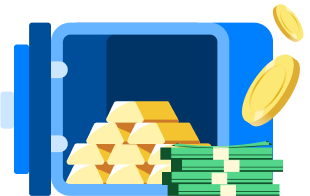
Table of Contents
Modified On:
Stuck in a financial struggle? Don't know a way out? Read these solutions to pull yourself out of it.
To understand the concept of debt trap let’s begin with a small story. Suppose your income is Rs. 10,000 which is insufficient to meet your demands.
Let’s say you want to buy a fancy watch or an iphone worth Rs. 80,000. In such situations, you seek the help of loans.
You take a personal loan for the same amount with Rs. 5,000 monthly EMI from a bank. Later in the following month you get Rs. 10,000 again, but half of it went to pay off your loan and remaining part of it wasn’t sufficient for you, so you apply for a loan again.
Thus, the cycle starts. Loans if not paid off timely will lead you into debts.
If you fail to pay the previous debt and keep on taking new ones you will spiral in this trap, called the- Debt Trap.
Along with having a strategy for savings and investment another most important criteria to be financially able is having a debt strategy.
Having a debt strategy will help you overcome debt, manage your finances and help you live a financially healthy life.
You won't have to worry about being stuck in the shackles of the debt monster. But first, let's understand what a debt trap is.
What is a Debt Trap?
The debt trap happens when you over consume your loans to pay off your previous debts, resulting in an EMI Trap.
Once you get yourself in a situation where the debt spirals uncontrollably and goes beyond your capacity of payment, you fall into the debt trap.
How can we measure it? There are a couple of ways to indicate a debt trap.
- EMI-Salary Ratio: Let’s look at an example for this, if your EMI is ₹10,000 and your in hand salary is ₹ 20,000 your EMI ratio is 0.5. According to financial experts this ratio should be under 0.3.
- Loan-Asset Ratio: Your loan balance is ₹25 Lakhs and if you take a loan of ₹10 Lakhs, thus your loan-asset ratio will be 2.5. This ratio is suggested to be kept under 0.5 according to experts.
In this case, you will either have to seek alternatives to increase your income or reduce your loan amounts in order to grow your assets or else you will be pulled into this spiral of debt trap.
How Does a Debt Trap Work?
At the point when you acquire a loan from a moneylender, two components come into power - the first is the principal loan amount (the amount you get), and the second is the interest (the amount the bank charges on the principal loan amount).
You can gain ground in reimbursing the loan when your principal begins decreasing. Yet, there's a hitch here.
Whenever you reimburse the loan consistently, you make an instalment towards both the principal as well as the interest.
This is on the grounds that most loans have equal amortisation structures.
That implies your loan is intended to be paid off in a progression of fixed instalments over a loan residency, and every instalment you make towards your loan applies to both the principal and the interest.
In the event that you can't stand to make instalments, you are probably going to fall into an obligation trap. How?
The principal amount doesn't decrease, and the interest continues to increase, making it inordinately difficult to take care of your loan.
What Causes Debt Trap?
These are the reasons that lead you into a spiral. If any of the points feels familiar to you, it's time to keep your expenses in check.
- You have once or more than once exhausted your credit card limit
- Your fixed expenses takes up more than 70% of your income
- You cannot put aside money for savings
- You have too many loans
- Paying EMIs is more than 50% of the income
- Loan application has been rejected
- You have exhausted your credit card limit: It is so easy when you have to swipe left and right and get whatever you want from your credit card. You do not have to take the headache of worrying about it anytime soon. If ever, you max out your credit card and exhaust its limit, you must realise that you are not standing financially strong and need to reconsider your decisions regarding finance. You could be in a debt trap- beware!
- Your EMIs exceed 50% of your income: A lot of people spend compulsively because finances and loans are available so easily. They get attracted to enticing sales, heavy discounts and offers and end up purchasing expensive things with the help of EMI. If you look at it, these EMIs may not be a huge amount of money when when accumulated together these make up to be an amount that is significant and you eventually have less money to spend on other things that are important. When you see that your EMI amount is nearing 50% of your income. That’s a red flag- that’s your warning that you are becoming a victim of a debt trap.
- Your fixed expenses are more than 70% of your income: EMI isn't the main financial commitment; there are other fixed costs you really have to deal with on a monthly basis. These costs are school fees, gas or electricity bills, rent and so forth In a perfect world, your fixed spending on necessities to income not be over half; assuming if it is more than 70% of your pay, it's red flag that you are gradually getting yourself in the financial spiral of being in debt. Specialists demand that you really want somewhere around 30% of your pay for different costs and to meet your monetary objectives.
- You have too many loans: If you have issued multiple loans and are paying it at different times of the month, it may be really exhausting. Not only do you exhaust yourself, but you also put yourself at a risk of defaulting. In addition to that, you might lose a good sum of money by paying multiple loans.
- You cannot afford to put aside money for savings: One of the most logical reasons that you may not be able to save every month is because your debt cycle is so huge. There has to be a balance between the debt and your fixed expenses. This may be another sign of getting yourself into debt.
- Your loan application is rejected: If your loan application has been rejected, that is the ultimate red flag of why you might be falling into a debt trap and why you should get out of it as soon as possible. Whenever you apply for a loan, the financial institutes and banks check your credit score to determine if you are loan worthy or not. They will check your CIBIL score and if you are foot deep in debt with no financial capability to take the responsibility of another loan, you will not be liable for any further credit. Even if they do, they will be granted to you at a much higher rate of interest and slowly push you towards the spiral of debt, where there is little or no hope of return.
How to Come Out of the Debt Trap
- Acknowledge the problem that defines it: Following are the ways that can help you with your poor debt situation, if you ever happen to fall into any:
What can you do to make it better?
- You must first of all accept that you have a debt problem
- Analyse and determine the reasons and areas that are pushing you towards a debt trap
- Create a plan to control these areas
- Plan out a budget and map your needs and spends
- Make a budget and prioritise your needs: Once you analyse your budget and debt situation thoroughly you will be able to point out the most important, not so important and non essential needs.
- Create a priority list
- Repaying debt must be the first priority and doing this will have an everlasting effect on your financial situation positively
- Limit your spending for your non-essential and semi-essential list of things until you are financially healthy and capable again.
- You can choose for a debt consolidation loan: If you are paying for different debts during different times of the month, you might as well try consolidating your debt of high interest by getting yourself a low interest personal loan or a debt consolidation loan. Once you get the debt consolidation you will just have to think about only one payment every month.
It will help you to:
- Save money on interest
- Make proper EMI payment on time
- Debt is paid off faster, and
- Regain your financial vigor
- Automate the payments: As a borrower it is your duty to timely repay your loan in EMI, a financial commitment that you make with your lender. You can even automate your payments to make sure that you are consistent with your repayment. There are various advantages that is used to set up an ECS mandate with the bank or the financial institution that automatically sets up payment with the given benefits:
- Make payment at regular time
- Credit score increases
- Paying timely will reduce the debt faster as your interest is saved and so is the penalties and late fees.
- Avoid taking on more debt: If you have borrowed until the grip you should prohibit borrowing more. It should be made a rule to keep a ratio that is less than 40%. If you do not imply this, you will be straining your finances that will be unsettling for you. You will be able to avoid a financial disaster that will make you lose all your money.
- Look for ways to increase your income: The only formal way to get out of debt is to accumulate more income. More the income, more financial security you will have and thus be able to pay off your debt quickly and easily. You can pick up freelance gigs or a second job that fits your skill set, knowledge and experience.
- Pay off the expensive loans first: If you do not consider the debt consolidation you can take the trouble of paying your debts separately (remember to take one debt on one time) create, analyse and pay off the most heavy loan first.
- Check your credit score frequently: What is the hallmark of a good borrower? A Credit score. If your credit score is above 750, then congratulations! You will be among the premium people who are seeked by the best lenders. You will get the best interest rates, best loan teams and get a healthy financial future. You must always keep a tab on your credit score. You can make a point to request a credit report in every 3 months of a loan account. You should check whether the records are filled correctly.
- Get help professionally: We understand that sometimes, it might be very overwhelming to get out of a debt trap on your own. But don’t worry there are professionals who will help you to make your life easier. If you ever feel financially lost- the best decision is to seek help from a financial expert. There are financial professionals who can counsel you and make you understand your budget and restrain you from spending too much. There are some professionals who will extend their help to even negotiate with the lender from your side so that they alter the terms of loans that is more favourable to you!
Debt Consolidation – A Clever Solution to Come Out of Your Debt Trap!
We will bring to you the best way that keeps your financial health an A plus. If you carry around multiple high-interest loans or outstanding credit card balances, you are slowly stirring a recipe for a financial mess.
Have you heard the old saying, ‘Too many cooks spoil the broth?’ Likewise, taking a low-interest personal loan is a smart move in order to be debt-free.
The personal loan helps clear all your outstanding balances and convert your multiple payments into a single monthly payment made towards your debt consolidation personal loan.
Why does taking a debt consolidation loan make sense?
- A debt consolidation loan allows you to lower your interest rate, reduce your monthly payments, and pay off your debt quicker.
- It brings you more financial freedom and helps you to budget your monthly expenses properly.
- Since you need to make just a single monthly payment rather than multiple loan EMIs, you reduce or eliminate the chances of missing payments, thus avoiding late fees and higher interest rates.
- It ensures timely payments that improve your credit score and enhance your creditworthiness for future loans.

Save Money in Digital Gold

.svg)







.png)
.png)











.jpg)


